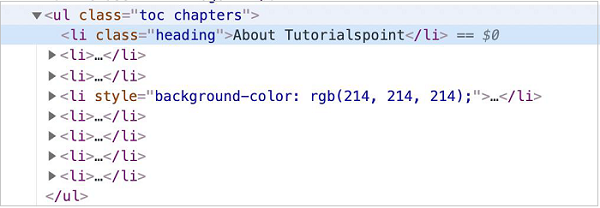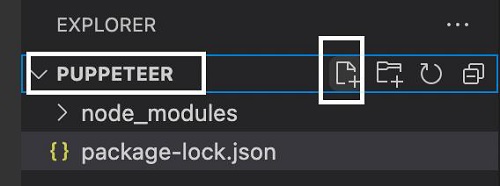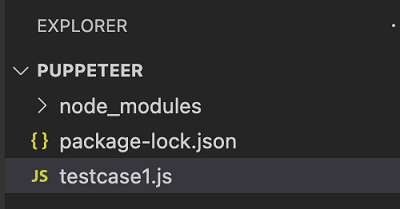
- Puppeteer - Home
- Puppeteer - Introduction
- Puppeteer - Element Handling
- Puppeteer - Usage of Google
- Puppeteer - NodeJS Installation
- Puppeteer VS Code Configuration
- Puppeteer - Installation
- Puppeteer - Basic Test
- Puppeteer - Non Headless Execution
- Comparison Between Puppeteer & Selenium
- Comparison Between Puppeteer & Protractor
- Comparison Between Puppeteer & Cypress
- Puppeteer - Browser Operations
- Puppeteer - Handling Tabs
- Puppeteer - Basic Commands
- Puppeteer - Firefox
- Puppeteer - Chrome
- Puppeteer - Handling Confirm Alerts
- Puppeteer - Handling Drop-downs
- Puppeteer - Locators
- Puppeteer - Xpath Functions
- Puppeteer - Xpath Attributes
- Puppeteer - Xpath Grouping
- Puppeteer - Absolute Xpath
- Puppeteer - Relative Xpath
- Puppeteer - Xpath Axes
- Puppeteer - Type Selector
- Name Selector & Class Name Selector
- Puppeteer - Id Selector
- Puppeteer - Attribute Selector
- Puppeteer - Handling Links/Button
- Handling Edit Boxes & Checkboxes
- Puppeteer - Handling Frames
- Puppeteer - Keyboard Simulation
- Puppeteer - Getting Element Text
- Puppeteer - Getting Element Attribute
- Puppeteer - Device Emulation
- Puppeteer - Disable JavaScript
- Puppeteer - Synchronization
- Puppeteer - Capture Screenshot
- Puppeteer Useful Resources
- Puppeteer - Quick Guide
- Puppeteer - Useful Resources
- Puppeteer - Discussion
Puppeteer - Locators
We can handle elements on page with Puppeteer. Once we navigate to a webpage, we have to interact with the webelements available on the page like clicking a link/button, entering text within an edit box, and so on to complete our automation test case.
For this, our first job is to identify the element. To get the property of an element uniquely we need to inspect it (right-click on the element then select the option Inspect). The ElementHandle objects are created by the methods - page.$, page.$$ and page.$x. These objects refer to an element or tag in a page.
To determine an element uniquely, we can either take the help of any of the attributes within the html tag or we can use a combination of attributes on the html tag. Mostly the id attribute is used since it is unique to a page.
However, if the id attribute is not present, we can use other attributes like the class, name, and so on. In case the attributes like id, name, and class are not present, we can utilise a distinct attribute available to only that tag or a combination of attributes and their values to identify an element. For this, we have to use the xpath expression.
Methods to locate elements
These methods are listed below −
page.$(locator value)
This method yields a Promise with the ElementHandle. The ElementHandle is an object of the identified element. If there are multiple elements having the same locator value, then only the first matching element from the top left corner of the page shall be returned.
page.$$(locator value)
This method yields a Promise with an array of ElementHandle. If there are multiple elements having the same locator value, then all matching elements shall be returned in the form of an array.
page.$x(xpath value)
This method yields a Promise with an array of ElementHandle. If there are multiple elements having the same xpath value, then all matching elements shall be returned in the form of an array. In case, there is one matching element, then the array returned shall have a single element.
The ElementHandle methods like elementHandle.$, elementHandle.$$ and elementHandle.$x can be applied to an element. In that case, an element shall be searched within the DOM of the present ElementHandle and not in the entire DOM.
In the below given image, let us take the example of an element having the li tag(having a parent element ul) and class attribute value as heading.
To identify it using the ElementHandle method on the page, the expression should be as follows −
const n = await page.$(".heading")
To identify it using the ElementHandle method on an element, the expression should be −
const m = await page.$("ul")
const p = await m.$(".heading")
Now, refer the image given below of an element having the li tag

Types of Locators
The types of locators in Puppeteer are listed below −
ID
Class
Type
Xpath
Attribute
Type
To work with the above locators we should have the basic understanding of HTML code. Let us take an example of an edit box having the below properties −

Here, input is the tagname. A tag in HTML may or may not have attributes. The type, class, name, id and so on are the attributes of the element.
For example, in the expression id = "gsc-i-id1", text to the left of = is the attribute name (id) and to the right of = is the attribute value (gsc-i-id1).
An attribute may or may not have a value assigned. Also, if a value is assigned, then it should be enclosed in double or single quotes. The value of an attribute is set by a developer as per his choice.
Let us take an example of an element having the below html code −

We can identify the first checkbox in the above image, with the expression −
const n = await page.$("input[type='checkbox']")
To begin, follow Steps 1 to 2 from the Chapter of Basic Test on Puppeteer which are as follows −
Step 1 − Create a new file within the directory where the node_modules folder is created (location where the Puppeteer and Puppeteer core have been installed).
The details on Puppeteer installation is discussed in the Chapter of Puppeteer Installation.
Right-click on the folder where the node_modules folder is created, then click on the New file button.

Step 2 − Enter a filename, say testcase1.js.

Step 3 − Add the below code within the testcase1.js file created.
//Puppeteer library
const pt= require('puppeteer')
async function checkBoxHandle(){
//launch browser in headed mode
const browser = await pt.launch()
//browser new page
const page = await browser.newPage()
//launch URL
await page.goto('https://the-internet.herokuapp.com/checkboxes')
//identify element with xpath then click
const n = await page.$("input[type='checkbox']")
n.click()
//wait for sometime
await page.waitForTimeout(4000)
//verify if checkbox is checked
const v = await (await n.getProperty("checked")).jsonValue()
console.log(v)
}
checkBoxHandle()
Step 4 − Execute the code with the below mentioned command −
node <filename>
So in our example, we shall run the following command −
node testcase1.js

After the command has been executed successfully, the boolean value true is printed in the console. This is returned by getProperty("checked") which returns true as the checkbox is selected.